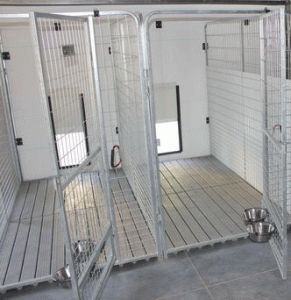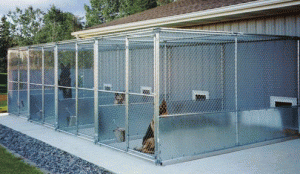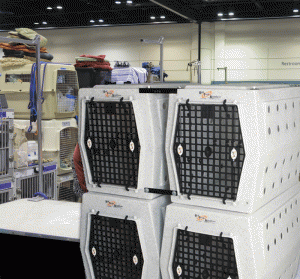A Better Way to Disinfect Kennels, Whelping Boxes, and Crates

By Vince Battaglia
As I toured the kennel, I noted the gleaming metal grates and debris-free padding of a well-scrubbed crate. Only a slightly sharp chemical smell tingled my nose. The owners had done their research. They not only chose a disinfectant certified to kill 99.99% of germs, but they even made sure the solution was EPA-approved to kill the germ they were most concerned about Canine Influenza (H3N8 virus and H3N2) and Parvovirus. Yet, as I continued down the row, I heard the unmistakable sound of coughing, choking, hacking noises that sounds like kennel cough. Or smell or sight of a sickness—give a detail. The kennel manager grimaced and shook his head in frustration. What more could they do? What was missing?
 Over the past three weeks, I have spoken to dozens of breeders, handlers, and owners from three different countries. Many had similar experiences. And most were not familiar with the term “dwell time”.
Over the past three weeks, I have spoken to dozens of breeders, handlers, and owners from three different countries. Many had similar experiences. And most were not familiar with the term “dwell time”.
So, what is dwell time and why does it matter? It’s some term owners come across in cleaning, but oftentimes overlook. “Dwell time” is the one of the most important steps in the disinfecting process because it’s the amount of time needed for a disinfectant to stay wet on a surface in order to effectively kill germs and bacteria. The required “wet” dwell/contact time can differ significantly from product to product, and if you don’t keep the disinfectant on the surface long enough, you won’t kill the germs. For example, Accelerated Hydrogen Peroxide is proven to kill Parvovirus within 5 minutes but 5.25% Household Bleach diluted 1:32 takes twice as long (10 minutes) to kill the same germ.
Where can you find this important info? Blogs and websites may point you in the right direction with positive reviews and anecdotal evidence, but they rarely mention dwell times. Perhaps less exciting but definitely informative, product labels contain “kill claims”, safety instructions, and dwell times. They have been carefully chosen through various third-party EPA labs and may differ based on the targeted germ and the specific product being tested. The CDC explains that some bacteria, viruses, and fungi have a natural resistance to certain disinfectants. To make sure your cleaning is safe and effective, use only products that are guaranteed to kill the germs you are concerned about.

Key Takeaways
Know the “kill claims”. Not all disinfectants are created equal. Remember, product labels list the microscopic organisms (bacteria, viruses, and fungi) that can be killed by each disinfectant. Also notice that most disinfectants have an Environmental Protection Agency (EPA) registration number. This number, in combination with the EPA establishment number, indicates that a disinfectant has been proven effective, with a minimal risk to the user.
Follow the “dwell time” instructions. As with many places I’ve visited, the kennel above considered safety and efficacy, but ignored the dwell time directions. Improperly used disinfectants are ineffective, so don’t put your animals at increased risk of infection: always read the label instructions before applying a product to any affected surface.
Decontaminate routinely. A regular cleaning schedule using the right product will help you protect the animals you love and cherish.
When in doubt, call us at Pathogend. We are the trained professionals and can offer advice and ideas to help you protect your dogs, animals, and kennels.
Contact:
Vince Battaglia
Phone: 678.575.2889

Short URL: https://caninechronicle.com/?p=130317
Comments are closed











